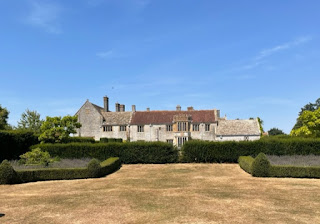When I started this blog in 2013, it never occurred to me that I could write about anything other than scones. But this project could have been about a long list of subjects. I could have chosen National Trust cappuccinos or National Trust car parks. Even as I type, there's a man called NTByBike who is busy cycling around all 600+ National Trust properties to test out the bike facilities.
One thing I could have reviewed, although I may have got sued or beaten up in the process, is National Trust volunteer guides. I have met some absolutely brilliant National Trust volunteers over the past nine years of this project and the ones at Lytes Cary Manor today were exceptionally good.
You may be wondering "how do you know when you're in the presence of a five-star volunteer guide?". Luckily, I have the answer: you know they're brilliant when you have to drag yourself away from them. You want them to follow you around for the rest of your life, pointing things out to you, eg "This Tesco Express used to be a haberdashery. They once sold some buttons to Larry Grayson." or "There have been 114 marriage proposals in this restaurant. 112 were accepted, although of those was later rescinded."
Anyway. Lytes Cary today had not one but TWO five-star volunteer room guides. A man called Ian told us all about the Great Hall. Then we met Sue who pointed out all the quirky stuff in the Great Parlour. What I loved about them was the enthusiastic honesty, eg "These figures by the fireplace are made out of leather. They're quite ugly but everyone has their own tastes."
But let me tell you about the history of Lytes Cary:
- The chapel is the oldest building at Lytes Carey. It was completed in 1348.
- It was built by Peter Lyte, the grandson of William de Lyte who founded the family.
- The Great Hall was built by Thomas Lyte in the 1460s, with the Great Parlour added in the 1530s.
- One of the most notable Lytes was "Henry the Herbalist" as the guidebook calls him. In 1578 he published the Nieuw Herbal, an English translation of a Flemish book on plants and their medical and other uses.
- But then it was all went a bit pear-shaped for the Lyte clan - they got into financial difficulties and had to sell up in 1755. However, they continued to make names for themselves. The Reverend Henry F Lyte wrote the hymn 'Abide with Me!' in 1847 while Colonel William Lyte was founder of the city of Adelaide in 1836.
- The manor fell into disrepair.
- In 1907, what was left of the manor was bought by Sir William Jenner and his wife. His dad had been Queen Victoria's doctor and had made a lot of money.
- The Jenners set about restoring the place as faithfully as they could, salvaging panelling and other fittings and furnishings from other buildings.
- The Jenners' daughter Esme died when she was 37 and so Sir William gave the place to the National Trust.
- The West Wing of Lytes Cary is now a holiday 'cottage' that you can rent out - details here if you're interested!
The Lytes Cary Scone
I need to tell you that I went to Lytes Cary during a heatwave. This may have impacted on scone quality, as I can't imagine that it's much fun baking all day in a small kitchen when the temperatures outside are hitting 32 degrees and above. But - and it's genuinely paining me to say this - the Lytes Cary scone was a bit stale.
The simple conclusion I have drawn after 9 years of eating National Trust scones is this: a fresh scone is 99% likely to be a good scone. If it's been baked in the last 2-3 hours, you almost cannot fail with it. The Lytes Cary scone was definitely a bit older than it should have been.
So at last minute, I decided to add Montacute to the itinerary. I'd loved it there when I went in 2015 and they were brilliant again today; a top class scone. In the cafe they had a sign, though, which made me feel even more worried for all those people working so hard to keep things going in National Trust food and beverage outlets at the moment:
But let's not despair! We need to let the National Trust F&B teams know that we appreciate them and hopefully things will improve again soon.
In the meantime, I've decided that my next blog will be National Trust Holiday Cottages. I will selflessly offer my services as a kind of Judith Chalmers of the NT, going about reporting on bed quality and local cuisine (scones, obviously). Selfless, I know, but surely someone has to do it?
Lytes Cary: 5 out of 5
Scone: 3 out of 5
Lytes Cary volunteers: 500 out of 5
Other National Trust scones in Somerset: Barrington Court, Bath Assembly Rooms, Bath Skyline, Brean Down, Coleridge Cottage, Dunster Castle, Fyne Court, Holnicote, Montacute, Prior Park, Tyntesfield





I'm really sorry to say this but... that is a bought in scone - I work in one of the tearooms and you can tell. The bought in ones are more shiny on top and have a hexagon shape (you see it in this one but it has been slightly baked out). I'm not sure what this means for the scone rating system!
ReplyDelete